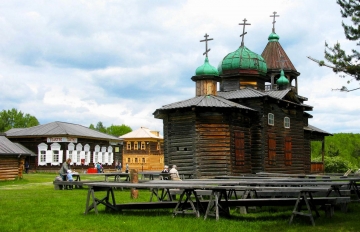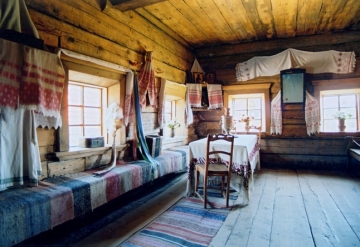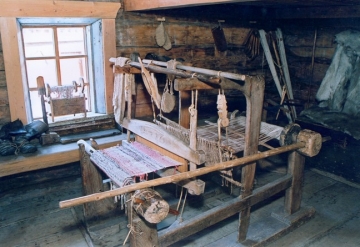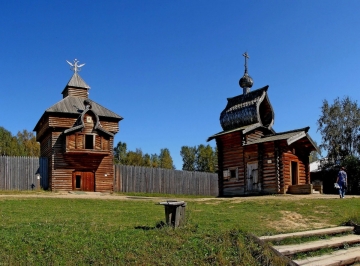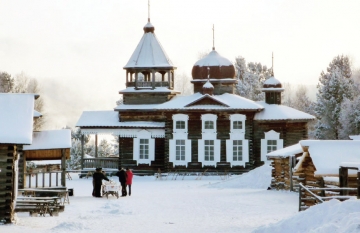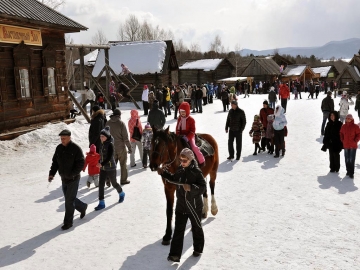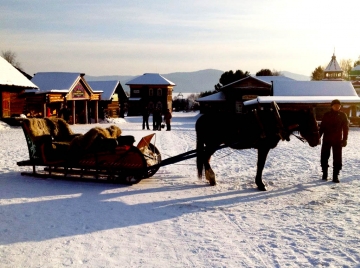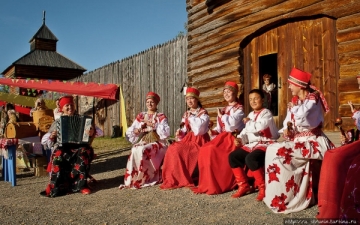Architectural-ethnographic museum "Taltsy" - a unique collection of monuments of history, architecture and ethnography of XVII-XIX centuries. The museum is located on the right bank of the picturesque Angara River in Talzy area of 47 km of Baikal tract on the way from Irkutsk to Lake Baikal. The museum complex in the open air attracts visitors the possibility of direct acquaintance with the material and spiritual culture of the peoples of the Baikal Region.
The museum retrospective recreated four historical and cultural Predbajkalja zones: Russian, Buryat, Evenki and Tofalar. Buryat, Evenki and Tofalars - the indigenous people of the region. Their way of life, the features of the life and beliefs tell Evenki and Tofalar camp complex Evenk and Buryat ulus burial sites-Letnik. Russian Angara- Ilim exposure zone, which contains wooden architectural monuments Predbajkalja XVII - XX beginning of the century, predominantly exported from the site Bratsk and Ust-Ilim areas Irkutsk region is represented by several expositions. Exhibition complex "rural municipality Village", which recreates the administrative center of the late XIX - early XX century, includes the parish school, homestead cantor, manor policeman Cossack.
Its main attraction is the unique historical and architectural monuments and the defense of religious architecture: Spasskaya Tower of Ilimsk Fortress passing in 1667 and active Kazan church in 1679. Picture of life in the old-Predbajkalja population complement cascade water mills of the late XIX century, the village-malodvorka consisting of peasant estates XVII-XIX centuries, Siberian cemetery mowing zaimka XIX century.
Modern Architecture and Ethnography Museum "Taltsy" is not only a place of preservation of monuments of folk architecture, but also a popular tourist destination. Deservedly enjoy the love Irkutsk and guests traditional folk festivals held in the Museum: Christmas, Carnival, Easter, Pentecost. Around the museum merged master possessing the skills of weaving, blacksmithing, production of products from birch bark and clay.
The museum retrospective recreated four historical and cultural Predbajkalja zones: Russian, Buryat, Evenki and Tofalar. Buryat, Evenki and Tofalars - the indigenous people of the region. Their way of life, the features of the life and beliefs tell Evenki and Tofalar camp complex Evenk and Buryat ulus burial sites-Letnik. Russian Angara- Ilim exposure zone, which contains wooden architectural monuments Predbajkalja XVII - XX beginning of the century, predominantly exported from the site Bratsk and Ust-Ilim areas Irkutsk region is represented by several expositions. Exhibition complex "rural municipality Village", which recreates the administrative center of the late XIX - early XX century, includes the parish school, homestead cantor, manor policeman Cossack.
Its main attraction is the unique historical and architectural monuments and the defense of religious architecture: Spasskaya Tower of Ilimsk Fortress passing in 1667 and active Kazan church in 1679. Picture of life in the old-Predbajkalja population complement cascade water mills of the late XIX century, the village-malodvorka consisting of peasant estates XVII-XIX centuries, Siberian cemetery mowing zaimka XIX century.
Modern Architecture and Ethnography Museum "Taltsy" is not only a place of preservation of monuments of folk architecture, but also a popular tourist destination. Deservedly enjoy the love Irkutsk and guests traditional folk festivals held in the Museum: Christmas, Carnival, Easter, Pentecost. Around the museum merged master possessing the skills of weaving, blacksmithing, production of products from birch bark and clay.
 EN
EN
 Русский
Русский

